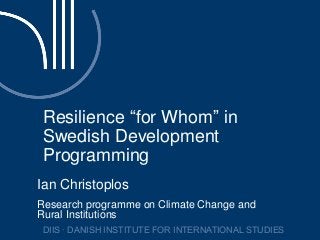
Ian Christoplos: Resilience for Whom
- 1. Resilience “for Whom” in Swedish Development Programming Ian Christoplos Research programme on Climate Change and Rural Institutions DIIS ∙ DANISH INSTITUTE FOR INTERNATIONAL STUDIES
- 2. Resilience and the development agenda Catchword, confusion or content? Sida reviewing experience and considering options for the future But hard to identify actual results, and their implications for a stronger resilience focus Also unclear what the ownership is for „yet another mainstreaming agenda‟ Discourse on definitions not very helpful DIIS ∙ DANISH INSTITUTE FOR INTERNATIONAL STUDIES
- 3. Basic challenges Resilience: Is it about systems or people? Can a development agency question linear development? Can resilience fit into the results agenda? Can resilience efforts reflect a human rights based approach? DIIS ∙ DANISH INSTITUTE FOR INTERNATIONAL STUDIES
- 4. Findings on resilience at Sida Many projects with potentially relevant activities (strong on capacity development and networking) Plausible theories of change, but untested Lack of clarity regarding the nature of climate risk, and who it is that is vulnerable Oddly enough, food security (as a key aspect of resilience) is stronger in the water portfolio than in agriculture DIIS ∙ DANISH INSTITUTE FOR INTERNATIONAL STUDIES
- 5. Resilience and rights Striving for resilient ecosystems may create goal conflicts for those living on the margins Resilience can justify green-grabbing if there is an undifferentiated perspective on vulnerability -safeguards not yet in place! Targeting for rights-based resilience requires more rigorous approaches to testing theories of change related to inclusive (gender, poverty, etc.) development DIIS ∙ DANISH INSTITUTE FOR INTERNATIONAL STUDIES
- 6. Resilience and results Often noted that the complex, dynamic and uncertain nature of resilience makes it very hard to evaluate But, if resilience is not translated into concrete indicators and outcomes in results frameworks, the prospects for transcending mere clichés are grim „Resilience for whom‟ implies defining results with a critical stance on the landscape of risk and differing forms of vulnerability DIIS ∙ DANISH INSTITUTE FOR INTERNATIONAL STUDIES
- 7. Entry points for clarifying whose resilience counts Differentiated risk and vulnerability analyses Analysing local resource scarcity and food security problems before proposing solutions („best practices‟ are not enough) Priority on outcomes related to adaptive capacities, and not just adaptive actions Plausible and tested theories of change DIIS ∙ DANISH INSTITUTE FOR INTERNATIONAL STUDIES
